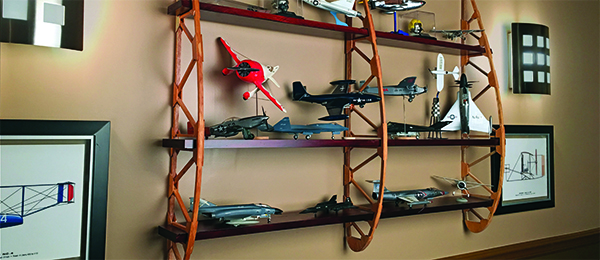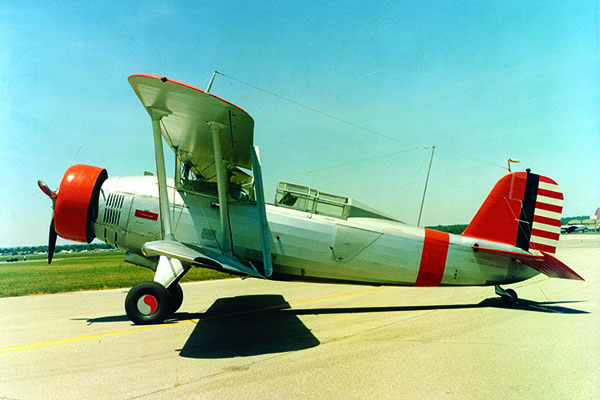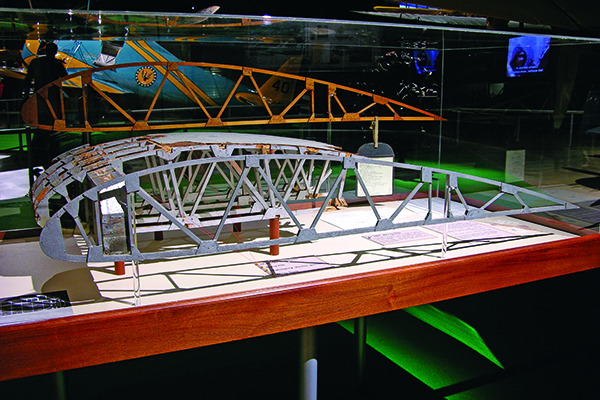O-38F Wall Shelf

Written by Mark Lanterman Make your own aviation-themed decor How-to article Read the full how-to acrticle in the July 2017 issue of Model Aviation.
Download free plans
 Click here for full-size plans 39.87" x 9.31"
Click here for tiled plans 8.5" x 11" (5 pages)
Click here for full-size plans 39.87" x 9.31"
Click here for tiled plans 8.5" x 11" (5 pages)
Inspiration
Sometimes it’s the inspiration of where an idea came from—the genesis if you will—that is as interesting as the idea itself. What had to happen to form that initial, creative spark? In the case of this little project, it was two things that were spaced many years apart. Pulling names out of my head is a futile attempt at the best of times, and I’m afraid that’s also the case here, but the first part of my inspiration was a few years ago. One of the many channels on my satellite system aired a miniseries following the exploits of a company that repurposed aircraft parts into chairs, tables, lights, etc. Although I don’t recall the name of the show, the company was MotoArt and it is still doing business in El Segundo, California. As part of each episode, I can remember them going out to aircraft boneyards, scrapyards, and the like, scavenging various tidbits both large and small that could be repurposed into a variety of items. Some of the scavenged parts were huge, such as stabilizers and engine cowls from airliners. These were typically turned into tables, desks, beds, and other large pieces of furniture. Mixed in with the large pieces were little things, including pistons and instruments that could be made into lamps and other decorative pieces. Having a passion for aviation, I found it entertaining to see how they modified, refurbished, and adapted these parts to create a variety of products that would look great scattered throughout my house, if only I had the budget! Skip forward a few years and there I was at the National Museum of the United States Air Force, my home away from home, in nearby Dayton, Ohio. Now, with the exception of the museum staff, I’m probably up there more than most any other visitor, with bimonthly and sometimes weekly trips if my schedule allows. Often I am researching a project, but sometimes I’m there simply looking at the little stuff, as I was during this particular visit.
In one corner of the Early Years hangar is a biplane suspended from the ceiling, an O-38F.
In one corner of the Early Years hangar is a biplane suspended from the ceiling, an O-38F. It doesn’t appear to have anything special to make it outstanding, which is typical of many observation aircraft designs. This particular airframe had crashed on June 16, 1941, because of engine failure, roughly 70 miles southeast of Fairbanks, Alaska. The pilot, Lt. Milton H. Ashkins, and his mechanic, Sgt. R.A. Roberts, were uninjured and hiked to safety. The abandoned airframe remained in the Alaskan wilderness, exposed to the elements, for 27 years until recovered by the museum in 1968. It was in remarkable condition despite the amount of exposure to the elements. Only the wings needing extensive restoration (see Photo 02). As part of the exhibit, directly beneath the restored O-38, is a Plexiglass case showing parts of the original, damaged wing section, consisting of several ribs and spars. Mounted above the original pieces is one of the recreated ribs. I studied that rib, paying attention to how it was made. Suddenly it hit me like a bolt of lightning. Instead of repurposing expensive aircraft parts like MotoArt, why not create something new with a vintage, handcrafted look, and a less-expensive price tag?

As part of the exhibit, directly beneath the restored O-38, is a Plexiglass case showing parts of the original, damaged wing section, consisting of several ribs and spars. Mounted above the original pieces is one of the recreated ribs.
I took several pictures and after a few days of sketching and resketching, I came up with this simple shelf unit!
—Mark Lanterman [email protected]










1 comments
O-38F Wall Shelf
Add new comment